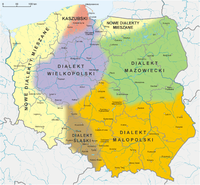Lesser Poland
The Malopolska , named after the language of the inhabitants of the former Duchy of Lesser Poland , is one of the four major dialect groups of Polish . It is spoken in the south of Poland, with Krakow as the center . The Lviv dialect of the former Polish city of Lemberg ( Polish: Lwów ) in the Ukraine was also based on a substrate from Lesser Poland .
Common features of all Malopolska dialects are the following:
- The so-called "Masurizing", d. H. the pronunciation of sz as s , of ż as z , of cz as c and of dż as dz (e.g. sary gray, zona wife, etc.);
- Assimilation of voiceless consonants to the following sonants, also across the word boundary (hence the characteristic pronunciation of the ending -śmy as -źmy );
- Change from -ch at the end of the word to -k ( na nogak on your feet, Krzan the horseradish ).
For individual Lesser Poland dialects, the good preservation of the original nasals ą and ę in the area around Kraków and the emphasis on the first syllable in the Podhale region are typical .
- Lesser Poland colloquial language :
- Cracow
- Beskider
- The dialect of the Gorals at the foot of the Carpathian Mountains is Goral : the most popular in Poland is the Podhale dialect, in which a certain amount of dialect literature was published; Goral was also spoken in Slovakia , where, according to Slovak linguists, it evolved into a mixed Slovak-Polish language ;
- Saybuscher
-
East Polish
- Lower East Polish and Upper East Polish
See also
literature
- Reinhard Olisch: Three Polish dialects. Goral, North Mazovian, Kujawisch (work from the Institute for Phonetics at the University of Berlin; Vol. 13). Harrassowitz, Berlin 1951.


